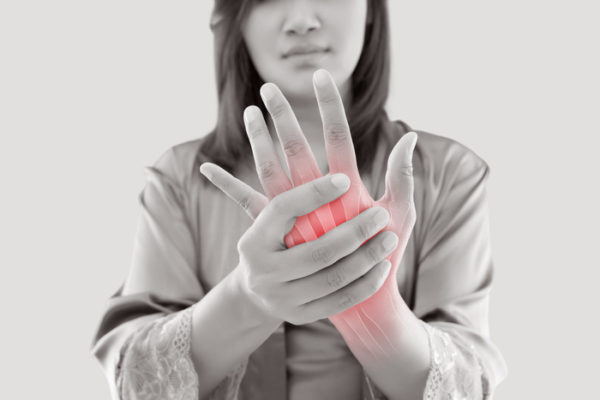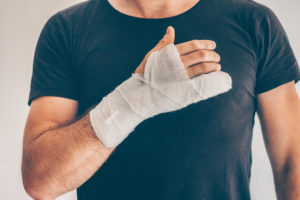Treating a Hand Injury After a Crash or Workplace Accident

Hand and wrist fractures, scrapes, and other injuries often occur after a car accident. And hand injuries are the second-most common work-related injury, sending more than one million workers to the emergency room each year (two out of five workplace hand injuries are from cuts or punctures).
The hands and wrists are made of many delicate bones, ligaments, nerves, and other connective tissue. Treatment for an injured hand depends on the location and severity of the injury. An injury can be especially frustrating or devastating if it affects a person’s dominant hand.
Common Hand Injury Symptoms
Not all hand injuries are obvious. After the endorphins and shock wear off, you may have suddenly felt pain or swelling in your hand or fingers. This could be anything from a bone fracture or soft tissue injury.
Here are the most common symptoms of an injured hand:
- Severe pain when gripping, squeezing, or moving the hand
- Swelling
- Tenderness
- Bruising
- Noticeable deformity (crooked finger)
- Stiffness in finger or thumb
- Numbness
You might not think your injury is that big of a deal or hope treating it at home will do the trick. See a doctor if you experience any of the following:
- Does not get better with home treatment
- Pain from the hand injury gets worse
- Does not respond to the treatment given by a doctor
- Arm pain
- Fever
- Exhaustion
If you think you have a broken hand or other internal injuries; experience sudden, unbearable hand pain; or have a visible injury that causes intense pain, go to the emergency room immediately.
Getting treatment now rather than later can mean the difference between a healthy recovery and long-term problems associated with poor healing, decreased range of motion, and weak grip strength.
Numbness and Tingling in Hands
Trauma to the hand can damage nerves and blood vessels. A pinched or severed nerve may manifest as numbness, weakness, or pain. You should seek immediate medical attention if you are experiencing numbness or circulation problems in your hand after a car accident.
Ligament and Tendon Injuries
 Tendons are tough cords of tissue connecting muscles to bone. Ligaments are tissues that connect one bone to another.
Tendons are tough cords of tissue connecting muscles to bone. Ligaments are tissues that connect one bone to another.
Damage to the muscles, ligaments, and tendons in the hand is sometimes referred to as soft tissue injuries. Unless the injury is severe, this can normally be treated with ice, rest, and elevation to help relieve the pain and swelling.
- Extensor Tendon Injury - Runs from the forearm across the back of the hand to the fingers and thumb, allowing them to straighten and flex.
- Flexor Tendon Injury - Runs from the forearm through the wrist and palm, allowing the fingers to curl and bend.
A drooping fingertip that will not straighten without assistance is called a mallet finger. This can happen as the result of a sudden blow that tears or jams the extensor tendon in the finger. It may feel bruised, swollen, and painful. Splinting the injured finger can help, and in some cases, surgery or physical therapy may be needed.
Another common injury to the hand affects the collateral ligament. These are small, connective ligaments that run along the sides of the finger bone joints. Heavy force can cause the ligaments to tear, usually at the PIP joint. A severe tear will require a splint to limit joint movement for several weeks.
A tendon or ligament that has been cut or crushed will likely need surgical repairs. It can take up to three months for the tissue to regain its strength, although full movement may never be regained.
Dislocated Finger or Thumb
Every finger has three joints and thumbs have two joints. A dislocated bone happens when it is pushed or pulled out of place. Dislocations often are caused by a direct hit to the joint, a fall, or sudden twisting motion. Soft tissues like ligaments, cartilage, and muscle may stretch and tear, and nerve and blood vessels may be damaged.
A dislocation happens most frequently in the middle joint of the finger. A dislocated finger may look crooked or misshapen, become swollen and bruised, radiate pain, or resist attempts to move it.
Do not pop the finger back into the joint. You could injure yourself further. Instead, apply ice and keep the affected digit immobile. Go to a hospital. Avoid eating or drinking anything in case surgery is necessary.
Broken Hand or Fingers
The hand features many delicate tendons and joints, plus 27 bones and 28 muscles. In a traffic accident or workplace accident, it does not take a lot of force for something to fracture a hand or finger. A fall, crushing impact, or twisting injuries can cause minor or major splinters to develop at the end or middle of a bone.
But sometimes it can be hard to tell if you have just sprained your hand or actually broken something. Hand fracture symptoms include:
- Swelling
- Bruising
- Sensitivity
- Pale or blue skin
- Pain that worsens
- Numbness in fingers
- Inability to move fingers
- Deformities
An X-ray is the clearest way to tell if a bone is broken or not. And just because you can move or close your hand doesn’t mean there isn’t a break somewhere.
Most hand or finger fractures do not require surgery and with proper treatment can heal within several weeks. A physician may recommend a splint, brace, strap, or “buddy” tape (an uninjured finger is taped to the injured one) to reduce movement and the risk of reinjury.
Serious fractures, such as when the bone breaks into multiple pieces or juts through the skin, will require surgical intervention. Local or general anesthesia will be used. Pins and wires or plates and screws may be needed to secure the bone in place for several weeks.
Read More: Signs of Wrist Fracture After a Car Accident
Degloving Hand Injury
A degloving injury means the skin has been scraped or torn off the hand or fingers, exposing the muscles and bones underneath. This is sometimes called an avulsion injury (or ring avulsion injury because the ring-wearing finger is caught). Avulsion and degloving injuries usually occur when a mechanism pulls on the hand, such as conveyor belts, rollers, presses, and wringers. In traffic accidents, degloving can happen when a tire runs over a person’s outstretched hand or forearm.
To repair the degloved surface, soft tissue or flaps may be harvested from the injured person’s body to use as skin grafts if the original skin is unavailable. This is a highly traumatic type of injury that requires immediate attention and surgery. Depending on the severity of the injury, amputation of one or more digits may be necessary. The expenses for reconstruction, therapy, counseling, and secondary procedures will be enormous and recovery painful.
Crushed Hand or Fingers
A crush injury can happen when a heavy object falls onto the hand or the hand is trapped because of a car accident. Crushed hand injuries damage important structures in the hand or finger, cracking bone, bruising muscles, or pinching nerves. You may experience swelling, dislocation, numbness, cramps, and a reduced range of motion.
It is important to get medical help as soon as possible. An X-ray can determine if any fractures are present and an MRI scan can identify soft tissue damage.
Treatment may range from a cast, splint, or surgery, and include physiotherapy exercises to stretch and strengthen the hand or fingers. Healing time will depend on the severity of the crush injury. Do not try to treat a crush injury on your own.
Read More: Crushed Limbs and Amputations: How They Happen, First Aid Tips, and When to Get a Lawyer Involved
Types of Hand Injury Treatments
 Minor hand pain and swelling can be reduced with at-home remedies. Use gentle stretching exercises such as rotating the wrists clockwise and counter-clockwise, flexing the hands as wide as possible then clenching it into a fist, and pulling the fingers of the other hand back towards you. A doctor or physical therapist can recommend other appropriate exercises.
Minor hand pain and swelling can be reduced with at-home remedies. Use gentle stretching exercises such as rotating the wrists clockwise and counter-clockwise, flexing the hands as wide as possible then clenching it into a fist, and pulling the fingers of the other hand back towards you. A doctor or physical therapist can recommend other appropriate exercises.
RICE therapy is used to treat a range of minor injuries. It stands for:
- Rest - Avoid using the injured hand as much as possible.
- Ice - Apply an ice or cold pack to the painful area several times a day for up to 20 minutes.
- Compression - Wrap the hand in a bandage, splint, or cast.
- Elevation - Keep the hand raised above the heart (a sling can help).
Other treatments that can be applied later on include massaging the hands, arms, and shoulders. Over-the-counter medication can also help relieve inflammation and pain.
Some hand injuries will require more serious medical intervention. For instance, a surgeon may need to perform a reduction (realign the bone) on a dislocated finger. A doctor may also prescribe that you wear a splint or buddy tape that may last for a few days to a couple of months.
Pursuing a Hand Injury Settlement
Gary Martin Hays & Associates can get you the hand injury settlement and treatment you need to move on with your life. If you have suffered a hand injury from a car accident or in the workplace, our personal injury team is here to fight for your rightful financial compensation.
An injured hand is a serious reduction in quality of life, especially if it affects the dominant hand. You may not be able to drive or go to work while you heal. Let us focus on the intricacies of insurance and the law and use our resources to your benefit.
Chat with our team now or call us at (770) 934-8000 to discuss your personal injury or workers’ compensation case.

 Find a location near you
Find a location near you